by Jena Gilmore | Sep 7, 2018

It’s that time of year again – Fair Season!
I can just smell the delicious scents of midway foods and see and hear the lights and squeals on carnival rides? But to most 4-H families, fairs go way beyond food and rides. During fair season, youth throughout the state dress up with pride in their 4-H green attire and prepare for what’s to come…fair exhibits!
Fair exhibits can range from artwork to plants to animals and finally, the epic fair booths. The most important thing for youth and adult exhibitors is knowing:
1. What counties are allowed to participate?
2. What and how many categories you may enter?
3. Exhibit requirements.
Here, we’ll cover preparing for fair booths and animal exhibits but you can find multiple links below for the state and local fairs with more information on exhibit entries and requirements.
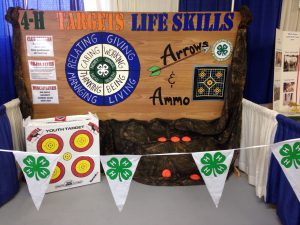
Fair booths are the highlight of displays at the fair
Organizations, like 4-H, use fair booths to visually communicate what we offer. Fair booths can be a great way to create a sense of Belonging in your club by having all members feel like they’re part of the 4-H Family! You want your communication to be effective, so prepare a checklist:
- Research the fair you want to enter – determine the deadline and registration requirements.
- Will you earn a booth premium? If so, figure out how much your club is willing to spend on supplies based on the premium could receive.
- Determine the size of your booth. Going out of booth boundaries can be a point deficit on the scorecard.
- Pick your booth theme and layout.
- Get commitments from members and parents to help with preparation, setup and breakdown. Delegate tasks so everyone feels like they have contributed.
Check out “Exhibits and Displays” below for a full checklist and more information!

4-H’er talking to the judge of the Rabbit Show at Walton County Fair.
4-H Animal Exhibits
Rabbit, chicken, cattle, swine and goat exhibits are staples of fair week. Animal exhibits give many people the opportunity to see, learn about and interact with animals they don’t normally come across. For our 4-H youth, livestock exhibits and shows give youth the ability to gain Mastery through 4-H Project Learning. These highly experiential experiences teach youth a multitude of life skills. To get your animals fair ready:
- Research the fair’s deadlines and registration. Be sure to check deadlines for acquiring ownership and birth-dates of your animals.
- Check the vaccination and health certificate requirements for your animal and secure an appointment with a veterinarian to have this completed.
- Be on time or early to check-in. Sometimes, there is only one Agriculture Inspector and a long line of exhibitors. Some animals are required to do on-site blood testing, so be prepared with your paperwork and be patient.
- Determine if the fair provides the food and bedding and if exhibitors are required to care for their animals daily. This is not only important for the nutritional well-being of your animal but also for their emotional well-being.
Helpful Links:
Florida Panhandle Fair Opportunities:
- Escambia- Pensacola Interstate Fair (also open to Santa Rosa and Okaloosa counties)
- Okaloosa- Northwest Florida Fair (also open to Escambia and Okaloosa counties)
- Santa Rosa- Santa Rosa County Fair (open to all counties in the Northwest District)
- Walton- Walton County Fair (open to Walton and Okaloosa counties)
- Holmes- Holmes County 4-H Youth Fair
- Washington- Washington County Youth Fair (Beef and swine livestock shows are also open to Holmes and Bay counties)
- Jackson- Panhandle Youth Expo (also open to Walton, Washington, Calhoun, Holmes, Liberty, and Bay counties)
- Bay- Central Panhandle Fair
- Calhoun- no county fair, but eligible to participate in regional and state fairs
- Gulf- no county fair, but eligible to participate in regional and state fairs
- Liberty- no county fair, but eligible to participate in regional and state fairs
- Gadsden- West Florida Livestock Show and Sale (open to counties west of the Suwanee River)
- Franklin- no county fair, but eligible to participate in regional and state fairs
- Wakulla- no county fair, but eligible to participate in regional and state fairs.
- Leon- http://northfloridafair.com/
- Jefferson- no county fair, but eligible to participate in regional and state fairs
If you’re a fair veteran, 4-H alumni, or just someone interested in benefiting the youth of your community, contact your local UF/IFAS County Extension Office to find out how you can become a 4-H Volunteer and share your expertise!
by Julie Pigott Dillard | Aug 31, 2018
With so many extracurriculars available these days, parents and kids are overwhelmed with choices.
To choose the right one, know what to prioritize, says Heather Kent, associate director of the Florida 4-H youth development program, part of University of Florida’s Institute of Food and Agricultural Sciences Extension.
“The 4-H motto is ‘To make the best better.’ The research shows that kids are more likely to find success as adults when they feel confident and capable in the face of new challenges,” Kent said. “You want to find a program where kids can find their spark in a safe environment.”
So, when comparing extracurricular programs, keep this checklist in mind, Kent said.
- Does it help them do better in school?
Look for programs that complement a child’s day-to-day school work. “Each 4-H activity has an educational component to it,” Kent said. “Compared to their non-4-H peers, 4-H youth report better grades, higher levels of academic competence and an elevated level of engagement at school.”
- Does it teach them how to speak up?
Give your child a chance to express him or herself to others. “4-H alumni often say that the public speaking skills they learned in 4-H have helped them throughout their careers, no matter which field they are in,” Kent said.
- Does it include STEM?
“One of the goals of 4-H is prepare young people for the workforce, which means introducing them to STEM — science, technology, engineering and math — through hands-on projects in areas like horticulture, robotics and embryology,” Kent said.
- Does it broaden their horizons?
“The members of a 4-H club may not all go to the same school or live in the same neighborhood. Meeting people who have different backgrounds from yourself expands your worldview,” Kent said.
- Is it a good return on investment?
Some programs give you more bang for your buck. “Annual registration for 4-H is $20, and there are scholarships available. That gives youth access to a wide variety of projects and events—everything from aerospace to agriculture. If not for their 4-H membership, they might have to join several other organizations to get all the same opportunities,” Kent said.
- Does it help them explore their interests?
“Finding a passion teaches youth about delaying gratification and taking pride in their work. That’s something they take with them into their careers,” Kent said.
- Does it develop organization skills?
Choose activities that require kids to stay on top of things and plan ahead. “For a project to be successful, 4-H members know they need to stay organized. For instance, you can’t raise a prize-winning animal without a plan for how you are going to reach that goal,” Kent said.
- Is it open to everyone?
Consider whether the whole family can participate. “4-H is open to both boys and girls ages 5 through 18. There is also collegiate 4-H and adult volunteering opportunities. Unlike other programs, 4-H is something everyone in the household can be a part of,” Kent said.
- Does it introduce kids to mentors?
Having adult role models who aren’t one’s parents is an important part of youth development, Kent said. “Our trained volunteers and Extension agents form a support system for 4-H members. Knowing that another adult cares about you is a big confidence boost and helps kids feel comfortable trying new things.”
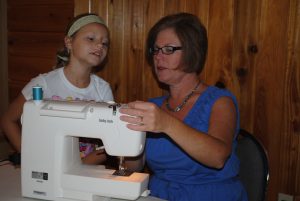
- Is it well established?
Learn about the history of the program. “4-H has been around for more than 100 years, and it’s been researched and developed through the U.S. Land Grant university system. In Florida, there are more than 200,000 youth in 4-H, and each of them benefits from being a part this longstanding, well known organization,” Kent said.
The mission of the University of Florida Institute of Food and Agricultural Sciences is to develop knowledge relevant to agricultural, human and natural resources and to make that knowledge available to sustain and enhance the quality of human life. With more than a dozen research facilities, 67 county Extension offices, and award-winning students and faculty in the UF College of Agricultural and Life Sciences, UF/IFAS works to bring science-based solutions to the state’s agricultural and natural resources industries, and all Florida residents. Visit the UF/IFAS web site at ifas.ufl.eduand follow us on social media at @UF_IFAS.
by Samantha Grenrock – Sam is a public relations specialist at UF/IFAS Communications. She loves animals, poetry and learning about science.
Shared with permission from the original author.
by Allison Leo | Aug 24, 2018
 Cooking with Florida Produce
Cooking with Florida Produce
Knowing how to cook and being comfortable in the kitchen is an important life skill that has enduring benefits. Leon County 4-H hosted a culinary day camp with a unique twist: educating youth about Florida produce and local agriculture. In addition to teaching culinary techniques and nutrition, youth learned foundational cooking skills and took things a step further by building connections between local farms and their kitchens.
Teaming up with Fresh from Florida Kids
Chef Paula Kendrick co-led the camp. featuring Florida-grown produce. The importance of nutrition and incorporating healthy foods into the diet was an ongoing theme during the camp. Lessons on how to read food labels, the importance of whole grain and limiting sugar intake were also featured. A salsa cooking competition using local products ended the camp. Chef Paula is from Florida Department of Agriculture and Consumer Services – Fresh from Florida Kids.
Local Farm Highlighted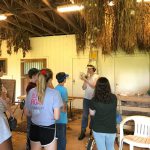
A visit to Full Earth Farm in Quincy helped youth see how a small local farm operates. Owners Katie Harris and Aaron Suko warmly welcomed the group to their farm and gave them a tour. Florida seasonality, composting benefits and how local farms provide fresh produce to businesses and homes in our area were tour highlights. The group left with a box of fresh summer squash to deliver to their next stop – Damfino’s Cafe and Market. Damfino’s sources local products for their menu items. Owner Lucy and Chef Max spoke to the group about their restaurant’s mission of connecting the local community to local farmers.
During the camp, youth were eager to try all the recipes and many of the campers tried new food items for the first time. Fresh herbs from the 4-H garden were used in a number of the recipes. Rosemary was added to honeydew sorbet, and basil was added to sautéed summer squash.
 Healthy Eating is Best Learned in the Kitchen
Healthy Eating is Best Learned in the Kitchen
Chef Paula Kendrick shared, “The students got to visit a Florida farm, eat at a local Florida farm to table restaurant and learn how to handle and cook fresh Florida produce. I love helping them to make that farm to table connection while teaching them about Florida agriculture. Cooking is one of the best ways to actually get them to try new things and to understand the importance of healthy eating and nutrition.”
For more information on healthy living 4-H projects such as cooking, contact your local UF/IFAS County Extension Office.
by aschortinghouse | Jul 27, 2018
GAGA BALL
If your youth has attended 4-H Camp Timpoochee or Cherry Lake with the UF/IFAS 4-H Camping Program, they’ve had the chance to play GaGa Ball. You’re probably wondering what kind of name is GaGa ball. It’s not just a made-up name. GaGa ball has a rich history. GaGa is translated from Hebrew as “touch-touch”. It’s said to have originated in Israel, and it has become a popular game at camps around the United States. GaGa Ball is a version of dodgeball and is just as fun.
LET’S PLAY!
GaGa ball is not only fun to say, but it is really easy to learn. First, you need a place to play. GaGa ball is played in a GaGa pit. Here’s just one of many articles on how to build your own GaGa Ball Pit. Next, you need a ball. GaGa balls are not specific, although a heavy duty dodgeball is recommended. The rules of the game vary place to place, but we play by the following rules at 4-H Camp:

- You hit the ball with your hands only.
- If the ball hits you below the knee, you are out.
- If the ball bounces of the wall and hits you below the knee, you’re out.
- If you hit the ball out of the pit, you’re out.
- If you hit someone in the face, you’re out
- If the game is going slowly, the leader can call “Hands-In”.
Hands in means everyone who is already out can put their hands over the wall of the pit and try to get those still in the pit out.
Rules can be made and altered to fit the group that is playing the game although the first two rules are staples of the game.
WHAT’S THE BIG DEAL?
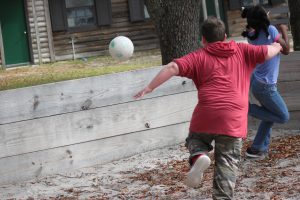
GaGa ball is a great way to expend extra energy during day camps, but it also is a great way to build and practice life skills. First off, youth are put in situations in every game where they have to practice decision making, discipline, resiliency and many other life skills 4-H strives to instill in our youth. Of course they have to practice their conflict resolution skills as there will inevitably conflicts that arise from their competitive natures. Most importantly, playing GaGa ball helps kids practice a healthy lifestyle. GaGa ball teaches many important lessons, and is a bunch of fun. So when you hear someone say, “Let’s play GaGa ball!”, give it a try and embrace the challenge.
Learn more about the history of GaGa Ball
by Whitney Cherry | Jul 13, 2018
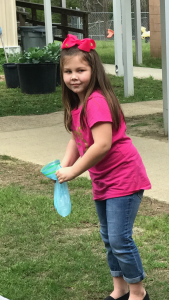
You can see the skepticism on this young 4-H’ers face! Try this activity with your kids and see this same look change to amazement and laughter when ice cream really does come out!
That’s right! It’s National Ice Cream Day, and you know in 4-H we learn by doing. So let’s beat the summer heat and make some ice cream!
Ingredients
1 c. half-and-half
2 tbsp. sugar
1/2 tsp. pure vanilla extract
3 c. ice
1/3 c. kosher salt
Toppings of your choice
Directions
1. In a small Ziploc bag, combine half-and-half, sugar and vanilla. Push out excess air and seal.
2. Into a larger Ziploc bag, combine ice and salt.
3. Place small bag inside the bigger bag and shake vigorously, 7 to 10 minutes, until ice cream has hardened.
4. Remove from bag and enjoy with your favorite ice cream toppings.
I know this activity doesn’t seem to fall under the heading of healthy lifestyles, but it does support our dairy industry- bonus! – and it’s riddled with science concepts. You can talk to your youth about salt being a catalyst, why we have to shake the bag for it to be creamy, or the awesome invention of ziploc bags and how people come up with ideas like that- aka the engineering design process.
But more than this, every time you do something new with your kids, not only are you making memories and strengthening relationships, you are building their confidence too. They are mastering new skills and becoming more independent. They become excited about sharing their new knowledge and experiences which improves their communications skills. It’s a win-win-win!
So whether you’re home with your own kids, are helping with summer day camps, or are planning club kickoff meetings for the fall, try this easy activity with your 4-H members, and have fun. Because sometimes learning is fun!
by Melanie Taylor | Jul 8, 2018
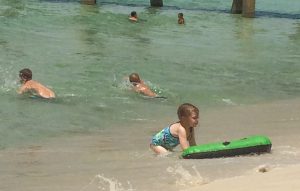
Summer is here! As the long, hot days of summer move forward, there are many things to consider when it comes to children and water safety. Each summer we hear of tragic incidents of children drowning in pools, spas, and other bodies of water. These tragedies may be avoided by following a few simple tips to keep your child safe while letting them enjoy their summer break.
The U.S. Consumer Product Safety Commission (CPSC) is the agency charged with protecting the public from unreasonable risks of injury or death from thousands of types of consumer products under the agency’s jurisdiction. In addition to Pool and Spa Safety, the CPSC is committed to protecting consumers and families from products that pose a fire, electrical, chemical, or mechanical hazard. CPSC launched the campaign, PoolSafely.gov, which provides Pool Safely: Simple Steps to Save Lives, a national public education campaign to reduce childhood drownings, submersion injuries and entrapments. Review these tips below.
Tips from PoolSafely.gov and CPSC:
- Never leave a child unattended in or near water.
It is recommended to designate an official “Water Watcher”, this is an adult assigned with supervising the children in the water. This should be their only task – they should not be reading, texting or playing games on their phone. Have a phone close by at all times, in case you need to call for help, and if a child is missing, check the pool first. Even when a lifeguard is present, parents and caregivers should still take the responsibility of being a designated “Water Watcher”. When the lifeguard chair is empty, the other lifeguards may not be able to see the entire pool and when lifeguards are sitting in low chairs; other people in the pool can block their view.
- Teach children how to swim.
Swimming is fun, great exercise and it is a lifesaving skill, so why would you not instill this skill in your child? Be sure to enroll children in swimming lessons – the earlier the better. A few swimming lessons may just save their life.
- Teach children to stay away from pool drains.
Show your children where the pool drain is located and remind them of the dangers of those drains. Remind them not to play or swim near drains or suction outlets, especially in spas and shallow pools, and never enter a pool or spa that has a loose, broken or missing drain cover. Sadly, children’s hair, limbs, jewelry or bathing suits, etc. can get stuck in a drain or suction opening. When enjoying time in a spa, be sure to locate the emergency vacuum shutoff before getting in the water.
- Ensure all pools and spas – both in your backyard and any public pool you may visit – have compliant drain covers.
The powerful suction from a pool or spa drain can even trap an adult, let alone a child. The Pool and Spa Safety Act is named after Virginia Graeme Baker, a child that tragically died from drowning due to a suction entrapment from a faulty drain cover. Do to this act, it is now required by law that all public pools and spas must have drain grates or covers that meet safety standards to avoid incidents like the one that took Virginia’s life.
- Install proper barriers, covers and alarms on and around your pool and spa.
One of the biggest dangers with pools or spas is when they are left open without any proper fences, barriers, alarms and covers. Each of these can be lifesaving devices. A fence of at least four feet in height should surround the pool or spa on all sides and should not be made of a climbable material. The pool should only be accessible through a self-closing, self-latching gate. Teach children to never climb over a pool gate or fence. Always remove portable pool ladders when not in use, just so your child is not enticed to enter the water. It is also highly recommended to install a door alarm from the house to the pool area, and keep pool and spa covers in working order.
- Know how to perform CPR on children and adults.
CPR can be the reason a drowning victim survives. With all of the possible locations of CPR trainings, why not get CPR certified as an extra precaution in case there is a water emergency? CPR classes are available through many hospitals, community centers, or by contacting your local American Red Cross. Once certified, be sure to keep the certification up to date.
- Finally, take the Pledge!
Before heading to the water with your family, remember to take the Pool Safely Pledge. This online call to action is a reminder to stay safer around the water. This pledge for you and your child can be found at https://www.poolsafely.gov/pledge/. The pledge is supported by CPSC and the PoolSafely.gov initiative and Olympic swimmer Michael Phelps along with over 60,000 other pledge takers. Parents, you can also download coloring sheets and other fun PoolSafely.gov child friendly apps and songs.
With the large variety of water related summer activities available it does leave a chance for risky incidents. Some work and preparation ahead of time will make for a less anxious and more fun-filled summer. Planning for risk will lessen the high-risk stakes and make sure everyone is prepared in case of an emergency. So remember, Simple Steps Save Lives. Enjoy a safe, fun, and water filled time this summer!
Resources: For more information be sure to visit Pool Safely: Simple Steps Save Lives – https://www.poolsafely.gov
by pmdavis | Jun 29, 2018
Summer time is a great time to teach youth about solar energy!
Use s’mores to teach your kids about two different types of energy: kinetic and radiation. Kinetic energy is energy in motion. Radiation is energy made through electromagnetic waves. Heat and light waves penetrate food without direct contact between the heat source and the food. Solar ovens, toaster ovens and microwaves are all methods of radiation cooking.
To make the solar oven like you see below, get a pizza box and follow these steps:
- Line the inside of the box with foil.
- Make an opening on the top of the box by cutting three sides leaving the other side attached so it flaps open.
- Cover the opening with clear plastic wrap.
- Assemble your s’more (see tips below).
- Close the lid of the box and raise the foil covered flap.
- Make sure the sun is reflecting onto the oven opening.

Remember to orient your box according the time and sun location. For example, if it’s late afternoon and the sun is on your right, you must be facing south. You would want to turn your oven so the reflective waves would be heating up your oven in more of a westerly direction.
Hints and Tips
- Place the graham cracker and marshmallow in the oven first.
- Add the chocolate once the marshmallow is partially cooked. (Otherwise, the chocolate will be liquid by the time the marshmallow is melted).
- Speed up the process by preheating your oven.
- Give yourself time and other activities to keep the group entertained. It took the group pictured above about an hour to have the tasty treat!
Want more science tips and ideas?
Check out these sites to discover more fun science: http://edis.ifas.ufl.edu/ , http://florida4h.org or http://utah4h.org/discover/.
For more information about how 4-H incorporates science into learning, contact your local extension office.
by Julie Pigott Dillard | Jun 22, 2018
 DID YOU KNOW that the sunniest place in Florida is Apalachicola? It sees an average of 241 days with sun…just one of the many reasons I love calling the Florida panhandle my home. I’m not exaggerating when I say I love being outdoors in the sun – going to the lake, fishing in the bay, kayaking down the creek, mowing the grass, picking blueberries, reading a book – I don’t want to imagine living anywhere else.
DID YOU KNOW that the sunniest place in Florida is Apalachicola? It sees an average of 241 days with sun…just one of the many reasons I love calling the Florida panhandle my home. I’m not exaggerating when I say I love being outdoors in the sun – going to the lake, fishing in the bay, kayaking down the creek, mowing the grass, picking blueberries, reading a book – I don’t want to imagine living anywhere else.
Along with my love of the sun comes the need for protection from its harmful rays. I’ve had my share of sunburns and learned the hard way how uncomfortable they can be. Sunburns happen quickly on summer days when the sun is closer to the earth – within the first 15 minutes of exposure. So check out these home remedies and tips to soothe your scorched skin when you’ve overdone it in the sun.
SOOTHE YOUR SCORCHED SKIN
- Take a cool shower or bath to calm your skin.
- Pour apple cider vinegar, witch hazel or cool milk on a soft cloth and gently apply to your sunburned skin.
- Add a cup of apple cider vinegar to a cool bath.
- Chill cucumbers, mash them into a paste and apply to a sunburned face.
- Drink lots of water to re-hydrate your body.
- Take an over the counter pain medicine like ibuprofen or naproxen.
RE-MOISTURIZE and RE-HYDRATE
Once you’ve soothed your aching skin, be sure to frequently re-moisturize your skin with aloe vera gel, petroleum jelly, coconut oil or lotions containing aloe vera or dimethicone. My brother, who is quite fair complected, even keeps aloe vera gel in the refrigerator. If your skin peels or blisters, leave it alone and allow it to heal! Never pick at or further peel your sunburn and certainly don’t pop blisters. Re-moisturize, cover your skin, allow it to heal and continue to drink plenty of water.
LIVING HEALTHY
In 4-H, we believe in living healthy and equipping our youth with the knowledge and skills to prepare them physically, emotionally and socially to meet life’s challenges. To learn more about participating in 4-H healthy living projects, visit the Florida 4-H Projects Page or contact your local UF/IFAS Extension office.
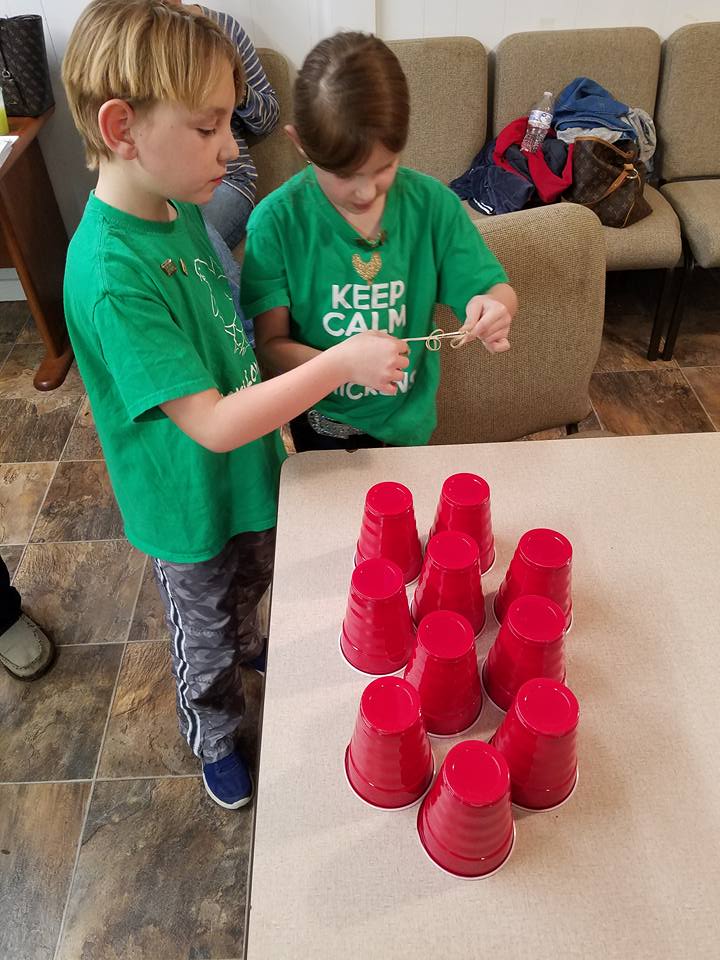
by Rachel Pienta | Jun 15, 2018
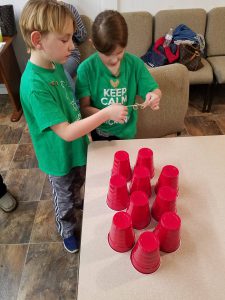
4-H members play the stacking game at a club meeting.
Summer is here, and I’m picturing long and lazy sunny days at the lake or beach. In Florida, the warm, sunny days of summer also bring afternoon thunderstorms and the possibility of tropical storms and occasional hurricanes.
What to do on rainy summer days?
During the summer months, the days of sunshine may be interrupted with periods of rainy weather. For children, rainy weather often means long hours spent inside the house. While some children welcome rainy days to spend time curled up with a book, reading for hours at a time will not occupy every child.
For parents looking for indoor activity options for children beyond movie marathons and video games, using household items already on hand can provide fun alternatives to endless screen time.
STEM CHALLENGE AT HOME
A fun activity that only requires string, rubber bands, and sturdy plastic cups will challenge your children to work together and think creatively to problem solve. The “Stack ‘Em Up: Introduction to Engineering Activity” challenges children to think like engineers. The activity is best done with 4 to 6 children. This is a great activity for children to enjoy when the neighborhood group converges on your house for a rainy afternoon! A complete instruction guide for this activity is included in the links below this article.
HOME KITCHEN CHALLENGE
A number of popular television cooking shows involve challenge competitions with special or limited ingredients. Parents can adapt this concept to help their children develop basic cooking skills while also giving them an opportunity to be creative and problem solve. This “do it yourself” at home cooking competition, adapted from PBS Kids, offers an easy fun way to engage children in creative kitchen fun:
• Divide the kids (or kids and adults) into 2 or 3 teams of 1 – 2 people.
• Gather a set of cooking items for each team – utensils, measuring instruments, bowls, etc.
• Choose an adult or older child to be the judge and/or the announcer/assistant. The judge can also decide on the “Secret Ingredient” that will be revealed to the contestants. Consider making it a fruit, a raw vegetable like carrot, cucumber, or celery, a grain item such as bread or cracker, or a spice like ginger or cinnamon.
• Set up individual or team “cooking stations”. Your cooking competition may be preparation only – without a stove, microwave, or oven.
Plan in time for taking turns cooking if your items will need to be heated or if appliances such as blenders or stand mixers will be used.
To add an additional layer of challenge, parents can decide to limit each time to one preparation method for individual teams or across all teams.
• Decide ahead of time how many additional ingredients competitors may “shop” for in the kitchen.
• Designate a separate spot for the judge or multiple judges to taste the food. This station should be equipped with a plate and eating utensils, and a palate cleanser like water or crackers. For more fun possibilities, create scoring cards with categories for taste, originality, good humor or sportsmanship, and presentation.
• Use a timing device like a kitchen or cell phone timer to add in the time element to the challenge. The suggested competition time is 20 minutes. The 20-minute time should include the child’s recipe planning time. Decisions will need to be made quickly!
• When time’s up, have each team present their creation to the judge, including a verbal description of flavors and the preparation technique. The judge(s) can taste each one and fill out the scorecards.
• Need ideas for prizes? Consider awarding a new cooking utensil like a colorful spatula with a certificate or card declaring the winner(s) “Master(s) of the Grand Spatula!”
• Want to involve additional older children or adults? Designate reporters to videotape and interview the contestants. Extend the fun by watching all the videos once the competition ends or before the winners are announced.
WHEN IT RAINS, GROW CREATIVE FUN FAMILY TIME AT HOME
The next time the summer forecast calls for rain, be prepared with these “rainy day” activity ideas. For more ideas, please contact your local UF/IFAS Extension Office.
How to Create a Cooking Challenge for Kids
How to Host a Cooking Competition for Your Kids
Stack ‘Em Up Activity
http://ngcproject.org/sites/default/files/9.6_stack_em_up_activity.pdf
https://www-tc.pbskids.org/fetch/games/activities/pdf/FETCH_StackEmUp.pdf
by Melanie Taylor | Jun 8, 2018

Gulf and Franklin County campers shooting rockets at Camp Timpoochee in June 2017.
As the school year wraps up, you’re likely trying to fill up your child’s summer with fun and educational programs. Fortunately, you’ll find a variety of day and residential summer camps out there. Does the thought of sending your child to camp cause anxiety for your or your child? If so, let’ me give you some tips to eliminate those concerns.
First, summer day camps and residential camps can be some of the most memorable events in a child’s life. Some children make memories and friends that last a lifetime. But as a parent, you need to feel comfortable about the camp you send your child to.
When starting the camp selection process, begin with your child’s interests. Make sure you know the camp will provide activities that will enhance your child’s personality and maturity level. Including your child in the process will help them feel more secure and excited about what camp will offer them. This will also help get rid of some of their anxiety because they’ll know what to expect (especially if they have never attended camp before).
Here are questions recommended by the American Camping Association (ACA) to help you make the best summer camp decision.
Questions to Consider in Selecting a Residential Camp:
- What locale do I want to consider? (mountains, oceanfront, distance from home, etc)
- Do I want a traditional camp that gives my child a wide variety of experiences, or do I want to select a specialty camp that focuses on a particular activity or set of skills?
- What size enrollment will make my child feel comfortable?
- How rustic do I want the camp to be?
- How structured do I want the program to be? Does my child like to have lots of choice in the activity schedule?
- Is my child ready to sleep away from home for an extended stay? (This will help you to select either a resident or day camp setting.)
- What session length will appeal to my child and to our family plans for the summer? (One week? Eight weeks? Length of day?)
- How can I stay in touch with my child during camp? Does the camp allow mail, phone calls or e-mail? Does the camp have parent visitation days?
- How will the camp meet my child’s special dietary or physical needs?
- What is my budget for camp tuition? (Remember, many camps offer financial aid.)
Questions to Consider in Selecting a Day Camp:
Day camps offer experiences unique from residential camps. Because of this, there are specific points to consider when choosing a day camp – transportation, overnights, swimming lessons, food service, horseback riding, group pictures, t-shirts, extended care, field trips, etc.
- Does the American Camp Association accredit the camp? (ACA has specific standards applicable only for day camps.)
- What training does the staff receive on safety, supervision, counseling, problem solving and other issues unique to working with young children?
- Is the price all-inclusive or are there extra charges?
- If transportation is offered, where is the closest pick-up location?
- Does the camp have an “express bus” which transports children quickly?
- If before and after-camp extended care is offered, who is with the children and what activities take place?
- Is lunch served, or do campers bring their own sack lunch? Are snacks and drinks provided?
- If the camp offers swimming, are there swimming lessons, or is it simply recreational swimming?
- Are campers in a group with a counselor all day? Or, are campers free to go from one activity to another with appropriate supervision? In this case, who would you talk to if you had a question or concern about your child?
- Is an open house offered before camp starts where you can meet your child’s counselor and van/bus driver?
- Are parents allowed to drop by for visits or is there a special parent visitation day?
Along with the above questions, you should also know that in the state of Florida, summer camps are not inspected or regulated by the Department of Children and Families (DCF). This makes it even more important for parents to gather information about the quality and safety of the program on their own. Parents should check to see if they are welcome to visit and observe the camp in action or attend activities with their child at any given time including water activities.
DCF suggests you ask these questions:
- What the programs health, safety and nutrition policies and procedures?
- Is the staff screened?
- What are the staff/child ratios and group sizes of the program?
- Is the staff well-trained?
- Is the program licensed or accredited?
- Are parents welcome to visit? Are family activities offered?
- Is there a daily lesson plan?
- Is the facility adequate for the number of children enrolled?
- What are the hours of operation, fees and payment procedures?
Download the Selecting Summer Care for School-Age Children: A Quality Checklist at http://www.dcf.state.fl.us/programs/childcare/docs/SummerChecklist.pdf.
Because you should know – Florida law does require summer camps to conduct background screenings of all camp personnel, including owners, operators, employees and volunteers. Volunteers providing less than 10 hours of service per month do not need to be screened as long as they are always within sight of a person who meets the screening requirement. In the state of Florida, the camps supported by UF/IFAS Extension meet each of the standards above.
The above questions and items to consider should help you in the camp selection process. Always feel confident in asking any questions – as the parent, you have the right to feel confident in your child’s camp selection.
As you begin your summer camp search, remember to check out the day and residential camping programs offered by your local 4-H program. We are confident in our volunteers and staff competency and would love to have your child participate in our safe and fun-filled summer camps. Contact your local Extension Office for more details.
Resources for this article may be found at: www.acacamps.org and www.myflfamilies.com.

















